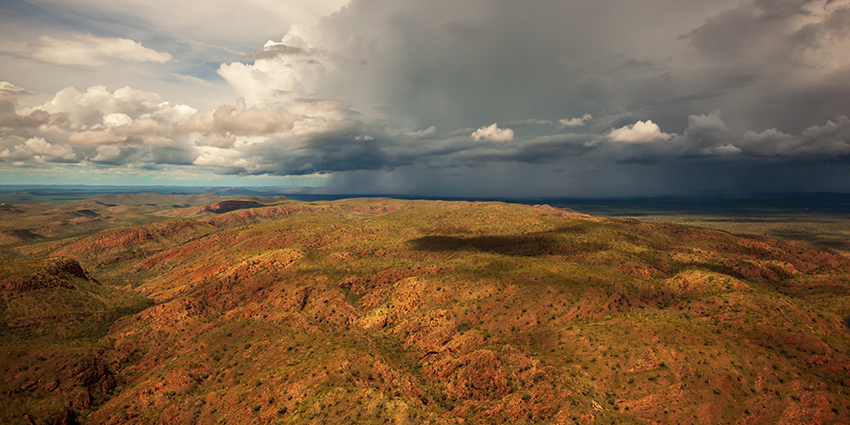Staying up to date on how climate change impacts local water systems is essential for WA’s water sector. It enables us to adapt more effectively to climate change and prepare for future environmental conditions.
Western Australia is already experiencing considerable climate change, including an altered water cycle. The state has warmed by about 1.3° since 1910 and the latest science shows climate change having rapid and intensifying impacts that vary across WA. Changes to rainfall, evaporation, streamflow and groundwater recharge are markedly affecting water availability in different ways in different places.
The Department of Water and Environmental Regulation is committed to:
- making complex climate and hydrology science easier to understand and apply
- facilitating strategic decision making about water management and climate adaptation, based on the best available science
- fulfilling needs across industries, government agencies, community groups and research organisations for credible, up-to-date and regionally relevant water information, guidance and tools.
Stay tuned! We are creating more resources for the water sector.
Your thoughts and needs matter. Please email hydroclimatescience@dwer.wa.gov.au:
- if you would like further information on climate science and water
- with ideas for future resources or feedback on those currently available.
Resources supporting WA’s water sector to account for climate change
Guide to future climate projections for water management in Western Australia
Show moreThe Guide to future climate projections for water management in Western Australia is a step-by-step, decision support tool that:
- provides a practical framework for selecting climate projections
- explains a contemporary approach to applying projections in a risk-based climate impact assessment
- enables water planners, scientists and decision-makers to assess potential climate change impacts
- replaces Selection of future climate projections for Western Australia (Department of Water, 2015)
- recommends using the Bureau of Meteorology’s National Hydrological Projections until the next generation of climate projections are available from WA’s Climate Science Initiative
- is relevant to all of WA.
Learn more about the guide’s purpose, strengths and seven-step climate assessment framework in the climate projections guide overview (2 pages).
National Hydrological Projections: use cases and comparing GCMs
Show moreTwo demonstration cases apply the Bureau of Meteorology’s National Hydrological Projections (NHP) to inform water management:
- Myalup groundwater system – assesses projected climate change impacts on a superficial groundwater resource in Australia’s South West
- Harding Dam Supply Reliability – explores a dam’s sensitivity to varying patterns of rainfall and evaporation under a range of plausible future climate projections.
A comparison of CMIP3 and CMIP5 climate projections across Western Australia compares precipitation projections between the NHP and previous 2015 guidelines for four WA regions. The NHP employs Coupled Model Intercomparison Project Phase 5 (CMIP5) global climate models (GCMs) whereas the 2015 guidance used CMIP3 models.
These resources help water planners, scientists and decision-makers use the NHP for local water resource assessment and management. Scientists from the Bureau of Meteorology and the Department of Water and Environmental Regulation collaborated on these studies.
Australian rainfall and runoff: A guide to flood estimation
Show moreAustralian rainfall and runoff: A guide to flood estimation is:
- a summary of the current understanding of the impact of climate change on design flood estimation in Australia (it is periodically revised)
- jointly led by the Department of Climate Change, Energy, the Environment and Water and Engineers Australia.
Australian Water Outlook and National Hydrological Projections
Show more- is an interactive website tool providing a summary of historical, forecast and projected hydroclimate information
- supports concise water resource management decisions
- is produced by the Bureau of Meteorology
- uses the National Hydrological Projections (see below)
- has associated region-specific assessment reports exploring plausible hydrological futures for Australia’s natural resource management regions. These reports are useful for mitigation and adaptation projects.
The National Hydrological Projections:
- are the latest generation of regional future climate projections from the Bureau of Meteorology
- include key hydroclimate variables such as precipitation, evapotranspiration, soil moisture and runoff as daily time-series data from 2006 to 2099
- suit a broad set of detailed applications and we recommend them for assessing the impact of climate change on water availability
- are gridded to a 5 km resolution nationally
- include projections for two greenhouse gas scenarios (RCP4.5 and RCP8.5) and four Global Climate Models which are Coupled Model Intercomparison Project Phase 5 (CMIP5) models.
Climate Change in Australia
Show more- provides a range of tools and reports from CSIRO and the Bureau of Meteorology’s 2015 national climate projections, including summary climate projection statements and climate model data
- currently has Coupled Model Intercomparison Project Phase 3 (CMIP3) and CMIP5 information.
My Climate View
Show moreMy Climate View is:
- an interactive website tool enabling farmers to access past, forecast and projected climate information relevant to their Australian location and commodity
- produced through a CSIRO–Bureau of Meteorology collaboration.
Disclaimer
Show moreThe Department of Water and Environmental Regulation publishes this information as guidance only and it does not represent government policy. Any representation, statement, opinion or advice expressed or implied in this webpage is made in good faith and on the basis that the department and its employees are not liable for any damage or loss whatsoever which may occur because of action taken or not taken, in respect of any representation, statement, opinion or advice referred to herein. Obtain professional advice before applying the information contained in this webpage.



